 |
| Category:
Conflicts/Others |

|
|
|
|
|
|
IRAQ; the unseating of Saddam
Hussein |
|
Some images and text from the AWM |
 |
|
The terrain in Iraq is
particularly hostile. Over ten
days in April 2003, members of RAN Clearance Diving Team 3 cleared mines
and other ordnance from 160 square kilometres of the coastal parts of
the peninsula. Petty Officer Clearance Diver Dean (“Jock”) Campbell
and Able Seaman Clearance Diver Colin Von Rechenberg walk along a
cleared path on the barren Al Faw peninsula in southern Iraq. |
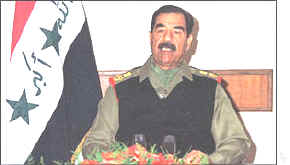 |
Saddam Hussein came to
power in Iraq in 1979, the same year the Shah of Iran was overthrown.
During the 1980s, as Iraq fought
a long, bitter war against Iran, the West supported Saddam as a moderate
bulwark against the spread of fundamentalist Islam. |
| By 1988,
however, when the Iran–Iraq war ended, the Iraqi economy was in ruins
and the West was turning away, repelled by Saddam’s use of chemical
weapons against both Iran and his own Kurdish population in the north.
Saddam’s answer, in 1990, was to invade the rich sheikhdom of Kuwait,
accusing it of undermining efforts to keep oil prices high.
In the First Gulf War the United
Nations authorised a United States–led coalition to eject the Iraqis
from Kuwait. After the war, the UN
Security Council demanded that Iraq give up its ballistic missiles and
“weapons of mass destruction” (nuclear, chemical and biological
weapons), along with any equipment and materials for making them.
Dissatisfied with Iraqi obstruction, the Security Council maintained
sanctions on most Iraqi trade throughout the 1990s.
| Lance Corporal Jason Nuske of the 2nd
Cavalry Regiment surveys the streets of Baghdad from an Australian
ASLAV-25 reconnaissance vehicle. He is wielding an FN Browning M2
.50-calibre machinegun. |
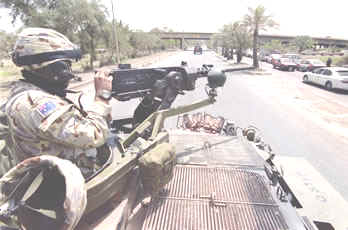 |
In 2003 the United States, asserting
that Iraq was still concealing weapons of mass destruction and alleging
links with terrorist groups such as al Qaeda, demanded military action
against the Iraqi regime. However, the Security Council did not agree: a
new group of weapons inspectors were still at work, and were reporting
very little in the way of prohibited weapons and materials. |
Unable to
obtain UN backing to overthrow
the regime of Saddam Hussein, the United States pressed ahead with a
“coalition of the willing”: the chief participants were the United
States, Britain, and Australia. The Second Gulf War commenced on 19
March 2003.
Saddam Hussein after he was dug out of a "rat
hole" on a non-descript farm after the end of the major conflict
section of the war. >>> |
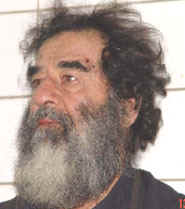 |
|
SASR & Special
Forces Operations Group in Iraq |
In Afghanistan in 2002,
the Special Air Service (SAS) had distinguished themselves in one of
their core capabilities, conducting long-range reconnaissance. In Iraq
the following year they were employed in a more directly combative role.
Elements of 1st Squadron, SAS,
entered Iraq on 18 March 2003, and may well have fired the first shots
of the war.
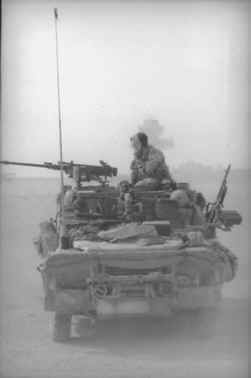 |
<<<
Australian SAS troopers at Al Asad airbase in April 2003. The
troopers’ Land Rover long-range patrol vehicle (LRPV) is armed
with an FN Browning M2 .50-calibre machine-gun and an MAG-58
general service machine-gun. AWM P04101-401
In western Iraq, the SAS
located and destroyed launch sites for Scud missiles that might
have threatened either coalition forces or Israel. Closer to
Baghdad, they were prepared to prevent any attempt to move
missiles towards the west.
Early in the war SAS
troopers were fighting running battles with Iraqi soldiers, who
tried to counter the Australians with machine-guns mounted on
4-wheel-drives. The SAS
themselves employed machine-guns mounted on their own long-range
patrol vehicles, along with rocket-propelled grenades and
shoulder-mounted Javelin anti-tank missiles. |
A notable success was the capture on
16 April of the vast Al Asad airbase west of Baghdad, near the Euphrates
River. There were over 50 aircraft, many still airworthy, hidden in
camouflaged shelters at the base. After capturing the airfield, the SAS
troops repaired the runways sufficiently to allow coalition Hercules
aircraft to use it.
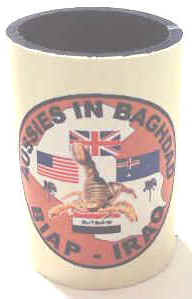 |
The Special Forces Operations Group
consisted of the SAS
contingent, together with commandos from the 4th Battalion, Royal
Australian Regiment (4RAR), and other attached groups. The 4RAR
troops were available as a ready-reaction force to come to the aid of
any SAS detachments which
got into trouble, but in the event they were not needed in this role.
However, they did assist the SAS in securing the Al Asad airbase in
western Iraq and elements of the special forces group entered Baghdad to
provide security when the Australian National Headquarters was set up in
the city.
<<<
Wherever you are the beer should be cold.
This is a stubby cooler for BIAP, in Iraq. |
Three CH-47 Chinook helicopters from
5th Aviation Regiment transported the ground troops between areas of
operation and helped supply the forces. Soldiers from various units went
to Iraq to provide security for Australian defence and diplomatic
personnel working in Baghdad. These included a detachment from the 2nd
Battalion, Royal Australian Regiment (2RAR), together with two light
armoured vehicles from 2 Cavalry Regiment.
Specialists, including some from the
Incident Response Regiment, were deployed to help deal with any weapons
of mass destruction which might be found. At Al Asad they helped inspect
the 8,000 tonnes of explosive ordnance found there, to ensure that it
did not contain chemical or biological weapons. |
|
Royal Australian Navy in the
Persian Gulf |
Since 1990, the RAN
has regularly provided ships to the multinational Maritime Interception
Force (MIF), enforcing UN
sanctions on Iraqi trade through the Persian Gulf (and at times in the
Red Sea). Before and after 11 September 2001, the MIF,
led especially by Australian frigate HMAS
Anzac, worked hard to tighten the blockade and stem the flow of
smuggled oil coming out of Iraq. Enjoying robust rules of engagement,
and able to operate in shallow waters, Anzac undertook night operations
to intercept smugglers close to the mouth of the Khawr ’Abd Allah
waterway.
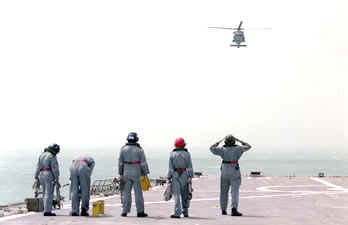 |
<<<
Crew on board HMAS Kanimbla await the arrival of a
helicopter from HMAS Anzac, in April 2003.
After September 2001, the
Australian presence in the MIF
was increased to three ships. Since then Australians have
regularly commanded the multinational operation, the first time
the MIF has
had non-American command. |
By 2003 the smuggling of oil
(and dates, another lucrative cargo) had been largely curtailed.
During the Second Gulf War, Australian
Captain Peter Jones commanded coalition naval operations in the northern
Persian Gulf. Operations included surveillance and inspection of all
shipping in the area, clearing the Khawr ’Abd Allah waterway, and
naval gunfire support by HMAS
Anzac in support of British forces ashore. In a notable
success, coalition boarding parties based in HMAS
Kanimbla seized three tugs and a barge preparing to lay
sea-mines to attack coalition shipping. |
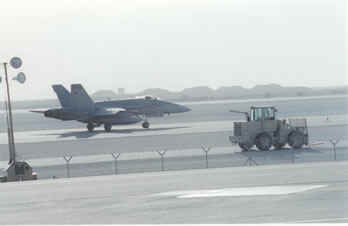 |
<<<
An F/A-18 Hornet aircraft of 75 Squadron taxiing at its base in Qatar on
27 April 2003. Fourteen RAAF Hornets flew over 670 sorties during the
war, including 350 combat sorties over Iraq.
Fourteen F/A-18 Hornet aircraft from
75 Squadron played a significant role in the war in Iraq. The Hornets
were based at Al Udeid air base, near Doha in Qatar. |
| At first they flew long
missions of five or six hours, escorting and protecting coalition early
warning AWACS
aircraft and tanker aircraft used for air-to-air refuelling. Later, at
the height of the war, the Hornets were used to attack Iraqi ground
forces with laser-guided bombs. Targets included tanks, trucks, and
artillery, as well as bunkers and storage areas for fuel and ammunition.
As Iraqi resistance crumbled, the Hornets also flew close air-support
missions to assist Australian and other troops on the ground as they
advanced on Tikrit, north of Baghdad, a centre of support for the
regime.
The RAAF
also sent two P-3 Orion maritime patrol aircraft and three C-130
Hercules transport aircraft to the Middle East. The Orions typically
flew long 12-hour missions, especially at night, over the Persian Gulf.
They assisted naval operations in the Gulf by keeping track of the large
number of small vessels in the area, both to curb smuggling and to guard
against the danger that they could be suicide boats packed with
explosives. As the war went on, the versatile Hercules flew supplies and
equipment into Iraq, and later flew some of the first humanitarian aid
into Baghdad.
|
|
IRAQ in 2004 |
After the overthrow of
Saddam Hussein’s Baath Party regime, a United States–led Coalition
Provisional Authority (CPA) was set up to govern the country, alongside
a 25-member Iraqi Governing Council. In June 2004, it has been agreed,
the CPA will
hand over power to a Transitional National Assembly and Iraq will regain
its sovereignty. A permanent government, elected in accordance with a
new constitution, is due to take over in 2005.
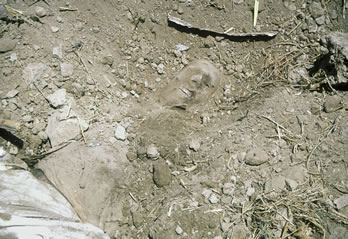 |
<<<
Under Saddam Hussein’s rule, hundreds of thousands of political
prisoners were executed or tortured at Abu Ghraib prison on the
outskirts of Baghdad and elsewhere.
Coalition forces found 993 unmarked graves at
the prison. |
In early 2004, Australia still had 850
personnel in the Middle East. HMAS
Melbourne was in the Persian Gulf, while RAAF
C-130 Hercules and P-3 Orion aircraft were operating in the region. RAAF
air traffic controllers remained at Baghdad airport, and soldiers
provided security for Australian diplomatic and government personnel.
Australians were also helping train the new Iraqi armed forces.
However, the situation in Iraq remains
tense. A brutal resistance movement remains active, targeting coalition
members, ordinary Iraqis, and international institutions, including the
United Nations and the Red Cross. These repeated attacks threaten both
political progress and the physical rebuilding of the country’s
infrastructure. Establishing a stable Iraq remains a daunting task. |
|
US
meritorious service medal awarded to Australians in Iraq |
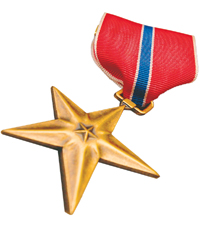 |
By
Pte John Wellfare, ARMY Newspaper
FOUR Army members have been
awarded the US Bronze Star for their service with joint headquarters in
support of operations in Iraq.
Col Andrew Smith, Land Warfare Development Centre, Maj Brent Maddock, HQ
1 Bde, Maj Scott Winter, 1 Armd Regt, and WO1 Patrick Hills, 1CSR,
received the medal, which is awarded for “heroic or meritorious
achievement or service ... in connection with military operations
against an armed enemy, or while engaged in military operations
involving conflict with an opposing armed force”.
|
|
Col Smith’s receipt of the medal was
announced alongside two Australian Navy captains by Minister for
Defence Robert Hill.
“Col Smith played a key role in the development of two essential
engineer works,” Mr Hill said.
“His efforts were pivotal to engineering improvements in Iraqi
facilities and infrastructure.
“Great strides were made in improvised explosive device awareness
due to Col Smith’s work and that of the staff under his leadership.
“Although exact numbers are unknown, the work probably saved
numerous lives.”
Maj Maddock, who served as the deputy chief of engineer operations in
the American corps headquarters from February to August, said
Australians serving with US forces in Iraq had earned a reputation for
performing well.
“I was the only, what we would call ‘regular’ soldier, in the
engineer operations section, the rest were reserves,” he said.
“My experience base was actually greater than the majority of the
people I was working for.”
One of Maj Maddock’s key duties while serving in Iraq had been the
maintenance of the main supply route for coalition resupply traffic.
The citation accompanying his Bronze Star praises his efforts to keep
the route open by coordinating missions to repair bridges attacked by
anti-coalition forces.
Maj Maddock also developed procedures for bridge repair tasks based on
the lessons of early missions.
Australians are highly regarded for their broad skill base and
subsequent ability to adapt to a range of situations and tasks.
WO1 Hills worked in the Joint Operations Centre in Iraq for six months
from August 2003 to January this year as the operations sergeant
major, responsible for the 15-member team that kept the centre
running.
“The staff underneath me used to run the battle map, used to do the
slide shows, run the radio system, keep the whole thing powered up and
this ran basically 24-seven,” WO1 Hills said.
“I had [US] reserves working for me who had, when I got there, done
six months and by the time I left they’d done 12.
“There’s guys that were there working with me that had two Bronze
Stars.
“For me it was actually quite surreal because I was working in a
corps-level operations centre, which had six divisions and 18 brigades
underneath it.
“You don’t realise what level you’re working at. The one I was
working in was 150,000 soldiers.”
The number of Australians receiving awards while posted to US-run
joint headquarters reflected the high regard in which the ADF is held,
WO1 Hills said.
“They love Australians, they’d have as many as they could working
in there with them,” he said.
“All of our guys who were embedded over there did a marvellous job.
“I’m obviously stoked and chuffed, especially as an other rank,
getting a Bronze Star. Most of the other people that have got the
Bronze Stars are officers.”
Deputy Chief of Joint Operations Maj-Gen Mark Evans presented the
medals to the 1 Bde members at a recent ceremony at Robertson Barracks.
|
 |
|
|
Australian Army
Training Team Iraq (AATTI) |
|
|